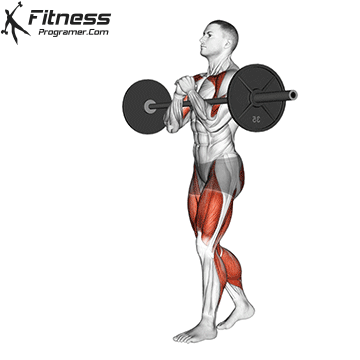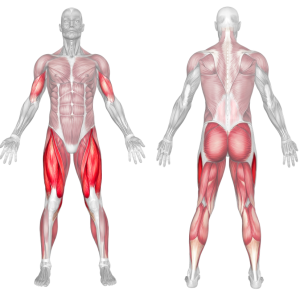How to perform the Zercher Carry

Load a barbell or weight: Load the barbell or weight that you want to use for the exercise. Start with a lighter weight to get the proper form, then gradually increase the weight as you get stronger.
Grip the weight: Stand in front of the barbell and weight with your feet shoulder-width apart. Squat down and grab the barbell with both hands, placing it in the bend of your elbows, close to your chest. Your elbows should be pointing forward and your hands should be resting on your biceps.
Stand up: Stand up, keeping the weight in the crook of your elbows. Keep your shoulders back and your chest lifted, and brace your core to maintain good posture.
Walk: Start walking with the weight, taking small, steady steps. Keep your posture straight, and avoid bending forward or to the sides. If possible, try to keep your eyes focused straight ahead to maintain good balance.
Finish the set: Walk for the desired distance or time, then stop and carefully lower the weight back to the ground. Repeat for the desired number of sets and reps.
Personal trainer tips: Proper form is crucial to minimizing the risk of injury, and it may be wise to start with lighter weights before moving on to heavier loads.
Make sure to keep your back and core straight and avoid bending excessively while carrying the weight. It is also recommended that you work with a coach or use a power rack with safety bars when performing this exercise.
Benefits of Zercher Carry
The Zercher carry is a strength training exercise that involves carrying a barbell or weights in the inner bend of your elbows. It is a type of weighted carry, meaning it challenges both your grip strength and core stability as you lift and move with weight.
1- Total-body strength development: The Zercher carry requires a great deal of core stability, as well as strength in the legs, back, and arms, making it a comprehensive full-body exercise.
Performing the Zercher carry regularly can help you achieve a stronger, more athletic physique and improve your overall strength and performance in other physical activities. Just make sure to start with a lighter weight and gradually increase the load as you get stronger to avoid injury and maximize the benefits of the exercise.
2- Improved posture: The Zercher carry is beneficial for improving posture because it forces you to maintain an upright position throughout the exercise. The position of the weight in the crook of your arms places additional stress on your lower back and abs, requiring you to engage your core muscles and maintain a straight posture. This helps to counteract the effects of prolonged sitting and other activities that can lead to slouching and poor posture over time.
Regularly performing the Zercher carry can help improve your overall posture by strengthening your lower back, abs, and other core muscles, as well as promoting better alignment and balance. Additionally, the exercise can help to reduce the risk of lower back pain and other posture-related injuries by building a strong and stable core.
It’s important to keep proper form when performing the Zercher carry to maximize its benefits for posture. Keep your back straight, engage your core, and avoid twisting or bending excessively while carrying the weight.
3- Improved balance and coordination: The Zercher carry requires you to maintain proper form and balance while carrying the weight, which can help improve your overall balance and coordination.
4- Increased calorie burn: Carrying heavy weights for a set distance requires a significant amount of energy, making the Zercher carry an effective exercise for burning calories and improving overall fitness.
The Zercher carry is a unique and challenging exercise that can add variety to your workout routine and help break up the monotony of traditional exercises.
The Muscles Worked During the Zercher Carry

